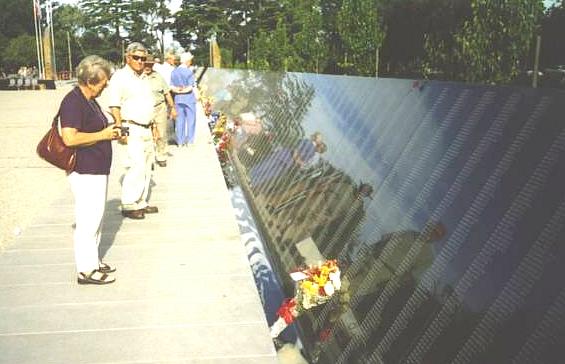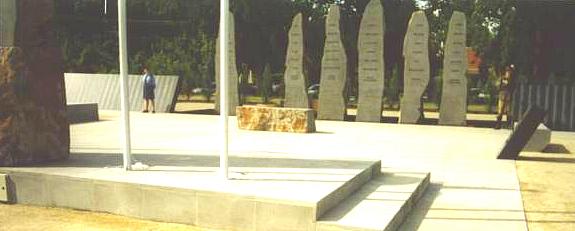
PNGAA Library
Australian ex-prisoners of war memorial and commemoration service for those who died on board the Montevideo Maru: Erice Pizer

A dedication service was held at the Ballarat Botanical Gardens on Friday 6 February 2004 for the Australian ex-Prisoners of War Memorial. The service was officially opened by the Chief of the Defence Force, General Peter Cosgrove, AC MC.
The Memorial honours more than 35,000 Australian men and women who were held prisoners during the Boer War, the First World War, the Second World War and the Korean War. About 8,600 Australian Prisoners of War died in captivity and of these, 4,000 have no known grave. The Memorial also honours 59 Australian Nurses who were captured and held as prisoners during World War 2.
 |
The POW Memorial - Joan and Brian Turner (Joan, nee Ashby - ex Kavieng - was evacuated 28 December 1941) |
The Monument is a stark 130 metre long, highly polished black granite wall, engraved with the names of all Australian Prisoners of war who were in the Australian Forces. At the end of the granite wall where the pathway ends there is a large stone simply engraved “Lest We Forget”. Water flows from beneath the stone along the base of the granite wall and into the Reflection Pool in which Obelisks stand. This cycle of flowing water symbolises spirituality, healing, cleansing, birth and re-birth.
At the centre of the Memorial are six large basalt obelisks with the names of all countries where Australians were held as prisoners of war. As mentioned, the Obelisks stand in a large Reflection Pool with one falling across the pool to represent those who have no known grave.
 |
The Obelisks |
Local sculptor Peter Blizzard designed the Memorial, which was built by a Ballarat construction firm.
On Saturday 7 February, a Commemoration Service was held for those who died on board the Montevideo Maru. On 22 June 1942, the Japanese ordered 945 Prisoners of War and 208 Civilians to board the Montevideo Maru for transport to Japan. On 1 July 1942, an American submarine attacked and sank the ship; it bore no markings to indicate that it carried 1153 Prisoners of War that were locked in its holds. There were no survivors and no indication of its sinking was given by the Japanese Government. The sinking of the Montevideo Maru is the largest maritime disaster in Australian history.
Mr John Clark represented the relatives of all those who died on the Montevideo Maru. Mrs Lorna Johnston (nee Whyte) was a nurse taken prisoner and sent to Japan 1942-45. Mrs Johnston spoke of her time as a prisoner with other nurses in Japan. Mrs Margaret Henderson laid a wreath for the relatives of civilians that were lost. The civilians' names are not recorded on the Memorial.